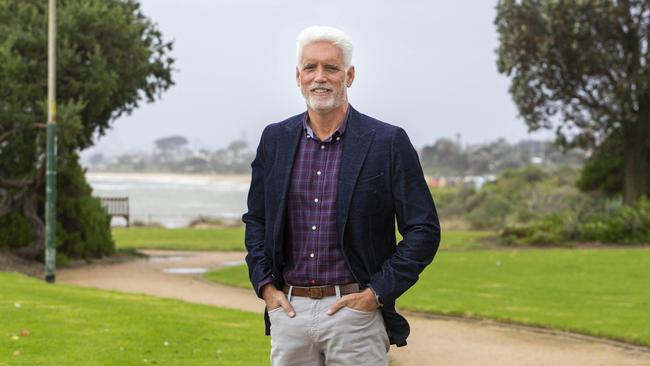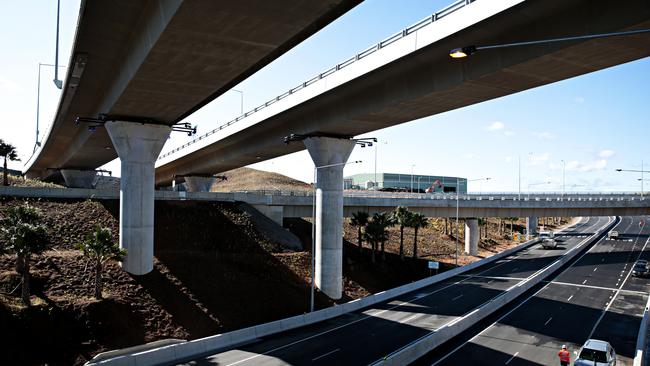NSW government inquiry shifting Transurban thinking on Sydney tolls
Transurban chief executive Scott Charlton thinks he can do something about the high price on Sydney’s toll roads and keep his shareholders happy at the same time.

Commuters in Sydney’s NorthWest know the numbers all too well.
A 34 kilometre trip from Hornsby to the Opera House at 5pm using the new NorthConnex tunnel, the M2 motorway, the Lane Cove Tunnel and the Sydney Harbour Bridge costs them $23.75.
By contrast a commuter from Seven Hills in the City’s Greater West, travelling the same distance to the Opera House at the same time of day using the WestConnex M4 motorway, pays only $8.52.
It’s a discrepancy that Transurban chief executive Scott Charlton wants to help the NSW government fix.
“Obviously the way the tolls were set up for the various assets were right at the time. But as the network moves on, as the city moves on, as needs change and the community’s expectations change, there’s probably a better way to get equality across the system in a way that maximises the system but also quality to the users,’’ Charlton tells The Weekend Australian.
The Melbourne-based toll road giant will control 13 of Sydney’s 15 toll roads by the time the last stage of the nation’s biggest road project, WestConnex, opens in 2023.
Transurban has also secured the competition regulator’s blessing to bid for the remaining 49 per cent of WestConnex, which the government plans to sell in two different tranches.
So Charlton wants to be a key player in the debate over toll road reform in the nation’s biggest city, especially with construction also set to begin next year on the Western Harbour Tunnel and the M6 tunnel through Sydney’s south.
A NSW parliamentary inquiry next month is scrutinising the stark discrepancies in tolling across the city’s motorways and the justification for toll increases on parts of the network.
It its submission to the inquiry, Transurban provides the first ever detailed economic analysis of the more than $13bn the firm and its partners, including the nation’s biggest super fund Australian Super, have ploughed into Sydney’s motorway network since 2013.
The research, commissioned by Transurban and published by KPMG, estimates the total economic benefits from the accelerated delivery of toll roads by the private sector to be $35.8bn over the 30 years between 2016 and 2046.
It argues businesses and freight users over that period can expect to realise an estimated $11.8bn in benefits through travel-time savings, including an estimated $4.3bn in savings for trucks alone.
Commuters stand to gain $9.4bn in similar benefits.
KPMG also estimates Sydney’s current and planned toll roads will generate Gross State Product (GSP) of $64.52bn over the 30 years between 2016 and 2046, or $2.5bn on average per year.
It expects this will lead to annual average job creation of approximately 5,300 full-time equivalent positions over the 30-year period.
The timing of the NSW inquiry is interesting for Transurban given the rise of the work from home phenomenon and increased cost of living pressures during the Covid-19 pandemic, which has put added scrutiny on toll charges.
In February the firm, which in December made the surprise hire of ANZ chief financial officer Michelle Jablko as its new chief financial officer, plunged to a half-year net loss of $448m, hit by an 18 per decline in average daily traffic on its road network, especially in Melbourne.
The decline in traffic would have been 23.6 per cent if not for Transurban opening the M8 and NorthConnex toll roads in Sydney.
While the firm has managed to keep paying dividends, they have been half the size of the payouts it distributed before Covid-19 struck.

Charlton was reminded again over the past fortnight about the fragility of the post-Covid-19 recovery, as a fortnight-long lockdown of Melbourne again crippled traffic volumes on its flagship CityLink tollway.
Even in the March quarter, while overall traffic volumes were up 1.1 per cent year-on-year, they were down 3.8 per cent compared with the same quarter two years earlier due to the weaker volumes on CityLink and on Transurban’s toll roads in America.
But Charlton sees no sea-change in the attitude to using toll roads in a post Covid-19 world, noting he has been through a number of economic cycles where cost-of-living pressures have risen.
Research commissioned by Transurban last year found that 8 per cent more people in Sydney intended to use private vehicles every day even once the immediate risk of Covid-19 had passed.
“I think what’s important is when people get used to the quality of the infrastructure and the benefits that it brings, they sometimes forget how it is paid for. I guess we’re trying to remind them the benefits that toll roads bring, the options that they have and the benefits they bring to a growing city like Sydney,’’ he says.
“If you look at most developed countries and those particularly with vibrant economies, they have some form of user pay models for their various systems whether it be in transport, utilities or whatever. Australia is not an island in that respect. If you look at the networks in Europe or the networks in the US, this is just a common way for providing infrastructure.”
But Charlton acknowledges the tolling regimes could be more transparent and equitable.
The variations in existing tolling methods and subsidies across the Sydney network are the product of decades of toll road development across the city.
The most recent toll roads — such as WestConnex and the M7 — have been distance based and pricing has been capped, a method which the NSW government has committed to for future tolled motorways, which is supported by Transurban.
“If you wanted to move the M2 or one of the other roads to a distance based charge and the charge equates to similar levels of what the toll was but it makes it much fairer for everyone on the road and improves the ability to move around all the different parts of the network so the network is more balanced, we are willing to consider all those things,” he says.
“We have our security holders. But what we’re saying is we think there can be a situation here where there’s a win-win, where we can sit down and make sure that our stakeholders aren’t losing and that the community and the government can also win. Clearly, we don’t want to be in a position that our shareholders over the term of the investment are going to be worse off. But we’re not seeking to get advantage. What we’re seeking to do is make the network perform better and for our customers to have a better experience. And so we’re open to having that dialogue.”
Other states, he says, could potentially follow Sydney’s example. In addition to CityLink, Transurban also operates six tollways in Brisbane.
“CityLink is a capped toll, it is not necessarily distance-based. So if you could move to some sort of consistency that is always helpful. We’re not looking for national consistency but it would be great to start with some form of consistency within each of the states,” Charlton says.
“Each of the states has different needs and different systems and then they also have to decide how the road systems integrate with public transport.”
Transurban is also proposing other changes in NSW to improve transparency on its networks, including providing consolidated toll notices to customers and trialling decision-point signage to give motorists choice about their travel plans.
The firm has completed a pilot study in Melbourne which provided information at selected entry points on the CityLink toll road about travel times compared to the alternate route. Toll price information was not included on the signs.
During the study almost 70 per cent of people surveyed who used the road said they would use the sign to inform future travel choices, and about 40 per cent said the signs helped inform their travel choice on the spot.
But some wanted toll price information displayed to allow them to make a fully informed choice.
Transurban is open to a discussion with NSW government to adopt a similar approach in NSW to include decision-point signage at key locations leading towards The M8 and M5 East, or the M1 leading towards NorthConnex and Pennant Hills Road.
“We think to create that customer trust and value, we need to be fully transparent on what they receive,” Charlton says, noting discussions are already underway in Sydney for similar trials.
“In our sector it takes a long time to get these trials up because of the approvals required.
We are trying and some of it is faster than others.”
Perhaps most controversially, Transurban is also proposing a trial on one of its Sydney tunnels to reduce the time ventilation systems are required to run overnight when traffic flows are very light.
It argues ventilation systems account for up to 70 per cent of the energy needed to operate road tunnels, so reducing the time they run would have huge environmental benefits, improving the energy efficiency of tunnels across Sydney by up to 14 per cent.
Importantly, Transurban argues the trial would have negligible impact on ambient air quality and would support the NSW government’s commitment to achieve net-zero emissions by 2050.
Additional monitoring is also proposed for the trial so that portal emissions can occur without causing any adverse health effects for people living around the road.
Charlton knows the trial is controversial, but says any proposed changes will be strictly informed by the data.
“We just go on the science. There is no change to the ambient air quality at these times (eg overnight) for the savings in emissions,” he says.
“Yes this can be a difficult subject for the community but all we can do is prosecute the science. Hopefully that makes sense in the longer term. Meanwhile we will fulfil all our obligations.”




To join the conversation, please log in. Don't have an account? Register
Join the conversation, you are commenting as Logout